Berbers › Bes › Etruscan Banquets » Origins and History
Articles and Definitions › Contents
- Berbers › Origins
- Bes › Who Was
- Etruscan Banquets › Origins
Ancient civilizations › Historical places, and their characters
Berbers › Origins
Definition and Origins
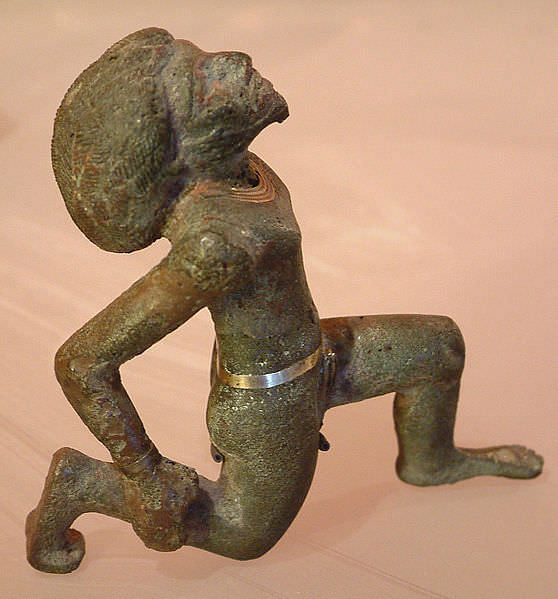
The Berbers have occupied North Africa, specifically the Maghreb, since the beginning of recorded history and until the Islamic conquests of the 8th century CE constituted the dominant ethnic group in the Saharan region. Modern Berber speakers and cultural practitioners are a minority in North Africa, though Berber groups are considered the descendants of pre-Arab inhabitants of the region. In most classical texts they are referred to as Libyans. A widely-distributed and diverse ethnic group, the ancient Berbers spoke a subset of the Afro-Asiatic languages, linguistically related to that of the Egyptians, Kushites, Arabs, Syrians, Levantine tribes, and Somalis. Known to themselves as Amazigh, the Berbers take their more common name from the Latin barbarus (barbarian), a Roman effort to distinguish the less-developed tribal societies of much of Europe and Africa from their own Hellenic -derived civilization. Libya is a Greek word derived from a regional title, and the term came to be used interchangeably with the concept of Africa.
ORIGINS OF THE LIBYANS
The presence of proto-Berber peoples from prehistory is evident in Saharan caves, where rock paintings depicting diverse megafaunal life point to evidence that before the desertification of the Sahara, northern Africa was a lush and resource-rich region populated by hunter-gatherer societies. The basal two deities of Berber cosmology - a solar figure and a lunar one - are loosely analogous to those of the Egyptians, suggesting a common cultural origin. According to Herodotus, who in his Histories wrote of the Berbers in 430 BCE,
“They sacrifice to the Sun and Moon, but not to any other god. This worship is common to all the Libyans.” (IV, 198)
In common with pre-Abrahamic Middle Eastern peoples, the importance of rocks was a major theme in Berber tradition. Some stone-cut mausoleums, such as the Roman-era Royal Mausoleum of Mauritania, built by Berber kings in traditional style, remain intact today. The Berber veneration of stone structures, which included the burial of the dead under outcroppings or erected monuments, was akin to such practices as the Nabatean pilgrimage to the Black Stone at Mecca's Kaaba and the Arabian Hutaymi people's worship of the great boulder Al-Weli abu Ruzuma. Similarities in tradition and language point to an ancient proto-Afroasiatic cultural center from which these groups dispersed.
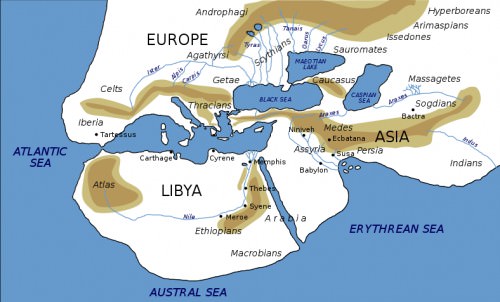
World Map of Herodotus
RELATIONS WITH EGYPT
The existence of powerful semi-nomadic tribes inhabiting the Maghreb was noted by Egyptian dynasties since the 13 century BCE; certain of these engaged in armed conflict with the Egyptians and thus among the pharaonic dynasties came to be regarded negatively and their societies styled as barbarian. The most notable groups from this period are the Meshwesh and Ribu, the latter from which the Greco-Latin term Libya is derived. A system of hieroglyphic writing was developed by the early Berbers, clearly derived from that of the more scripturally sophisticated Egyptians and evidencing strong cultural influence from the Nile region. The 3rd century BCE saw a literary shift in that Libyans began to form their own script based mainly on the Phoenician alphabet.
The Libyans were not always inclined to view the Egyptians as foes, however, in that they were willing to tolerate a certain level of protection from the pharaohs. In the 6th century BCE, Greek colonists began establishing an even greater presence at their established Libyan city of Cyrene. According to historian Susan Wise Bauer,
This did not go over well for the native North Africans [...] They sent a message to Egypt asking for help, and 'put themselves in the protection of the Egyptian king Apries.' So Apries sent out an Egyptian army [which] was decimated by the Greeks: they were, in Herodotus's words, 'so thoroughly annhiliated that hardly any of them found their way back to Egypt.' (502)
RELATIONS WITH CARTHAGE & ROME
By the time Carthage was founded under Phoenician thalassocracy in the 9th century BCE, larger Berber groups had already transitioned from hunter-gathering and pastoralism to sedentary pastoral-agricultural organization.
NORTH AFRICAN CHIEFDOMS PROVIDED SEAFARING PHOENICIAN COLONISTS EXACTLY WHAT THEY WERE LOOKING FOR: TRADING PARTNERS.
Native North Africans provided seafaring Phoenician colonists exactly what they were looking for: trading partners. On the coast, agriculture - likely adopted far earlier from interaction with Egypt and Fertile Crescent societies - became a dominant feature of Berber society. The two most prominent Libyan sedentary societies emerged by the 2nd century BCE: Numidia and Mauretania. Carthage, as a city-state, did not occupy an extensive land area and outside the Tunisian peninsula and the North African coast did not have much direct influence. Thus the Libyan kingdoms of the Numidians and Mauri enjoyed, at least for most of their history alongside Carthage, an independent commercial relationship. Numidian Berbers were also a major demographic within Carthage itself, though Phoenicians occupied the nobility and merchant classes, relegating natives mainly to serfdom and military conscription. During this time the Greeks began documenting North Africa and its kingdoms, shedding more light on the Berber tribes and their relationship with Carthage and being the first to refer to the people of the Maghreb as Libyans.
Mauretania, lying to the east of the Tunisian peninsula, traded heavily with Carthaginian claims on the North African coast. Led by tribal kings, the Mauri joined forces with Massinissa of Numidia (238-148 BCE) during the Second Punic War, joining forces against Carthage. The Roman term Mauri is the precursor to the term Moors used in later centuries to refer to the inhabitants of northeastern Africa.
Numidians were prized for their horsemanship and thus made up a significant portion of the Carthaginian cavalry during the Punic Wars. However, the standing of the Numidian kingdom with Carthage changed dramatically during the Second PunicWar. Massinissa, the powerful son of a Numidian chieftain and an ally of Carthage, betrayed the city when he saw that it was losing ground to Scipio ’s forces in the Iberian peninsula. He joined forces with the Roman Republic in 206 BCE. As a result, Massinissa was secured Roman backing to the throne of Numidia and helped defeat the Carthaginians at the Battle of Zama in which Hannibal was finally captured. The decisive victory ended the Second Punic War and legitimized Numidia as a Roman client state. Albeit restrained, Roman jurisdiction over Numidia under the rule of Massinissa led to a technological advancement of tribal Numidian Berber society, with most citizens moving to a complete sedentary agricultural way of life and the state participating in a growing Mediterranean trade sphere.

Numidian Mausoleum of Thugga
Two years prior to the sacking of Carthage in 146 BCE, the Roman Republic decided to legitimize various Numidian tribal leaders as heads of their own respective Numidian client states, likely to ensure stability and curb the prospects of a single Libyan ruler creating an empire in North Africa at the expense of Rome. All were grouped under Africa Proconsularis.However, subsequent chieftains made efforts to consolidate power in the region.
A century after the Roman victory in the Second Punic War, a leader named Jugurtha (160-140 BCE) bribed Roman authorities for occupation of the throne of Numidia and ousted the client establishment, leading to the Jugurthine War, the first major conflict between Rome and an independent Numidia. Jugurtha was captured and killed. Numidian relations as a client region would remain peaceful until the ascent of Juba II (85-46 BCE), a chieftain who united the Numidians and Mauretanians against Caesar. Likely wary of the potential establishment of Numidia as a directly-occupied imperial province instead of a client state, Juba sided with the Pompeians of the Republic during the Great Roman Civil War, a decision that cost him his life at the Battle of Thapsus in 46 BCE. The defeat ended the war and established Caesar as dictator. Caesar carved the existing province of Numidia into a new political entity, fully annexing it as the province of Africa (Africa Nova), which was in subsequent years renamed and reestablished as Numidia (Africa Proconsularis).
During these years of imperial reorganization, Roman jurisdiction over Mauretania was likewise changed from a client state relationship to provincial annexation. The political identity of Numidian Berbers did not change significantly during the Roman period; there was little if any Romanization among the tribes even though leaders were usually loyal clients and responded well to Roman rule. Only the Abrahamic religions - first Christianity, then Islam - would fundamentally change Berber way of life, and even then numerous ancient traditions would remain and prosper.
Bes › Who Was
Definition and Origins
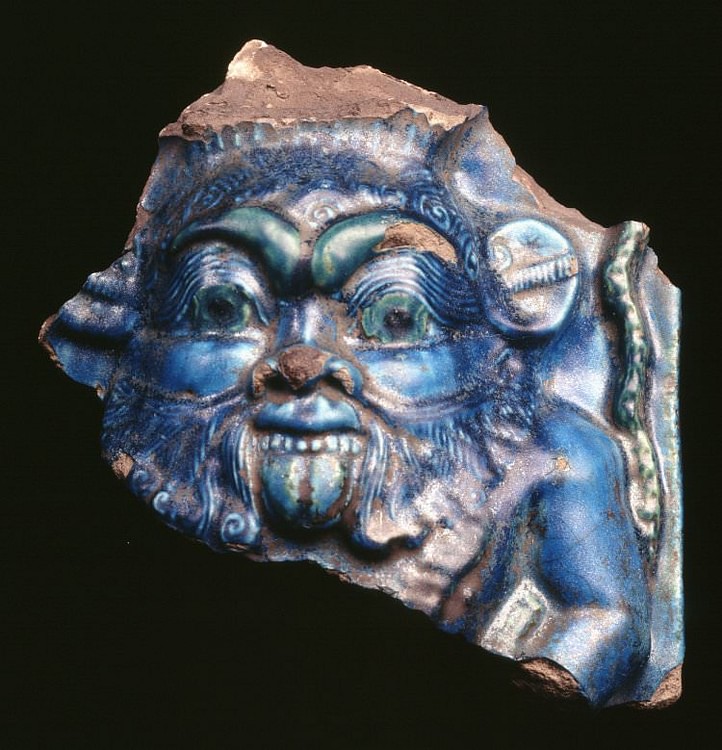
Bes is the ancient Egyptian god of childbirth, fertility, sexuality, humor, and war, but served primarily as a protector god of pregnant women and children. He is regularly depicted as a dwarf with large ears, long-haired and bearded, with prominent genitals, and bow-legged. Usually he is shown holding a rattle but sometimes a snake (or snakes), a knife, or sword. The image of Bes was often positioned at gates for protection and almost always appears outside of birth houses.
He was also a popular image used in household goods such as mirrors, cosmetic cases, on furniture, and as knife handles.His feminine aspect is Beset who appears in spells to ward off ghosts, dark magic, evil spirits, and demons. Bes himself is actually a demon, more than a god, but that word should not be understood in the modern sense. A 'demon' (from the Greekword daimon ) could be a good or bad entity along the lines of the Mesopotamian demon Pazuzu, who likewise presided over pregnant women and infants. Although Bes is frequently associated with his feminine aspect as consort, he is more regularly identified with the goddess Taweret (Tauret), the hippopotamus deity of childbirth and fertility.
ORIGIN & NATURE
BES, THE ANCIENT EGYPTIAN GOD OF CHILDBIRTH & FERTILITY WAS REGULARLY DEPICTED AS A DWARF WITH LARGE EARS, LONG-HAIRED & BEARDED, WITH PROMINENT GENITALS, & BOW-LEGGED.
Even though Bes was among the most popular gods of ancient Egypt, no story of his origin has been found. He shares similarities with at least nine other deities, according to Egyptologist Richard Wilkinson, who lists Aha, Amam, Hayet, Ihty, Mefdjet, Menew, Segeb, Sopdu, and Tetetenu along with Bes in near uniformity of role and likeness (102). What set Bes apart from these others, apparently, was his unique character. He was not a god in the same sense that Osiris or Thoth were, had no temple (except one protecting the grapes of the vineyard at the Baharia Oasis), and no formal worship, but was honored in the homes of the Egyptians from the time of the Old Kingdom (c. 2613 - c. 2181 BCE) through the Ptolemaic Dynasty (323-30 BCE) and on into the Roman Empire, although his popularity is most widespread from the New Kingdom of Egypt (1570-1069 BCE) onwards. His role as protector of children expanded to protector of anyone who placed themselves under his care and Egyptian (and later Roman ) soldiers had images of Bes inscribed on their shields and would drink from Bes-engraved goblets prior to battle.
The protective nature of Bes was expressed through his skill as a warrior who fended off evil but was also seen in his lighter side. In keeping with the Egyptian concept of the value of balance, Bes is as often seen in art laughing, dancing, and singing as he shown as a fierce warrior/protector. He was thought to entertain little children with his songs, and if a child were seen smiling or laughing seemingly at nothing, it was thought Bes was the cause. This may appear strange as Bes was most often depicted as an ugly, frowning dwarf who frequently displays his immense genitals, but as Wilkinson writes:
Despite his appearance, which changed in many details over time, Bes was deemed beneficent to humans and he was accepted by all classes of Egyptians as a powerful apotropaic deity [one who wards off evil and protects against bad luck]...Just as the Bes figure subsumed various minor gods and demons, in later times he was himself syncretized with other protective deities, forming the `core' of a composite deity whose elements included Amun, Min, Horus, Sopdu, Reshef and other gods. Mythologically, Bes could also be associated with Ra, Hathor, and Horus - and a female form of the god, Beset, sometimes appears as the mother of Horus. (102)
Although it has been suggested that Bes was originally a Nubian, Libyan, or Syrian deity, this is mainly speculation and, as Wilkinson and other Egyptologists note (Pinch and David among them), is unnecessary effort. The god first appears in art from the Old Kingdom of Egypt, and there seems no compelling reason to seek an origin for him outside of Egypt.
WORSHIP & DAILY LIFE
As there was no formal temple or clergy for Bes, neither was there formal worship. People paid homage to Bes in the home or at birth houses where he stood guard. Egyptologist Rosalie David writes:
Domestic gods were worshipped at a shrine filled with stelae, offering tables, water jars, braziers, and vases in a separate area of the home. Worship at home probably reflected the rituals performed in the great temples and would have included the presentation of food offerings and libations and the burning of incense in front of the god's statue. (Handbook, 118)
In more modest homes which could not afford stelae, offering tables, and vases, a simple statue of Bes would be placed on an altar and whatever one could afford would be offered. Bes was mainly worshiped through the everyday activities of the people as they went about their business. Bes was often carved onto furniture, for example, and especially beds to protect people (especially children) from evil spirits or ghosts which might come in the night.
Wilkinson notes how "the vast range of objects upon which Bes was depicted and the large number of his images and amulets demonstrate his great popularity as a household deity" (104). He appears on unguent jars, headrests, amulets, bracelets, couches, beds, chairs, mirrors, knives, and many other household items. He has been found in the ruins of the palace of Amenhotep III at Malkata and in the workmen's houses at Deir el-Medina. Rosalie David notes how the two most popular gods worshiped at Deir el-Medina were Bes and Taweret who appear frequently together in art found in the most modest to the grandest homes in that area (Handbook,118).

Cosmetic Spoon Handle with the Image of Bes
David points out how Bes was integral in the most basic aspects of life as a god of "love, marriage, dancing, and jollification" who also "assisted at childbirth and protected the young and weak" (Handbook, 118). As part of his duties, he was entrusted with encouraging toilet training in the young and also taught both boys and girls to be brave, to fight for justice, but also to enjoy life and sing and dance. He further could influence a boy's occupation in that a child (almost always male) who had the same short and chubby body type as Bes was thought to have been chosen by the gods as a Merchant Priest, a member of the clergy who monitored the goods which came into and went out from the temple. Bes was considered a protector of these goods and Merchant Priests were often Bes-like in body type. He also encouraged girls in their domestic duties and, like Bastet, guarded their secrets and protected their health.
BES & WOMEN'S INTERESTS
Bes was originally, and remained chiefly, the god of pregnant women and childbirth. Women who were experiencing difficulty in conceiving would visit a Bes Chamber (also known as an incubation chamber) at a site such as the Temple of Hathor at Dendera where they would spend the night in the god's presence. In the time of the Ptolemaic Dynasty, these Bes Chambers were decorated with images of a naked Bes with an erect phallus and a naked goddess to encourage fertility and healing.Women regularly used or carried objects engraved with the god's likeness and even had images of him tattooed on their bodies. Egyptologist Geraldine Pinch writes:
Egyptian "old wives" probably told stories about the antics of Bes, but they do not survive in the written record.The evidence for dwarf deities is mainly pictorial. They appear on magical objects, bedroom furniture, and items used to contain or apply makeup. Bes amulets and figurines were popular for over 2,000 years. Some women even decorated their bodies with Bes tattoos to improve their sex life or fertility. (118)
From the New Kingdom onwards, Bes became increasingly depicted in the company of the pregnant Taweret in images celebrating birth and fertility. Pinch notes, "Bes and Taweret were also the guardians of the divine infants worshipped in the Birth Houses of temples of the first millennium BCE. Temple and magical texts give Bes or Bes-Shu the role of opening the womb to allow a child to be born" (119). These birth houses were a regular aspect of temples all over Egypt and featured statuary or inscriptions of Bes outside and wall paintings of Bes and Taweret inside. One of the best-known images of Bes, in fact, comes from the birth house at the Temple of Hathor at Dendera. Scenes from these birth houses were often painted on the walls of homes and even appear on the walls of the worker's house at Deir el-Medina to encourage fertility and ensure protection.

Taweret
Female musicians regularly carried amulets of Bes or had tattoos of the god to inspire their art. Prostitutes also were tattooed with images of Bes as Egyptologist Joyce Tyldesley notes: "Prostitutes used their musical skills to entice their clients and a link between music, feminity, sex, and even childbirth is suggested by the Bes tattoos on musical prostitutes's thighs" (130).Priestesses, dancers, and musicians would also tattoo themselves with images, however, and scholars disagree on whether it was primarily prostitutes who decorated themselves with images of Bes or this was a practice observed by women in the arts and Egyptian religion generally. The dancer Isadora of Artemisia (c. 206 CE), for example, was a famous castanet dancer who had a tattoo of Bes on her thigh. Isadora was a free woman and a highly paid artist who commanded a price of thirty-six drachmas a day, travel expenses, insurance for her wardrobe and jewelry, and meal expenses. No records indicate in any way that she was a prostitute.
Bes in his feminine form, as noted, was frequently associated with Hathor and, by this link, to the concept of the Distant Goddess. The Distant Goddess was a deity who left her home to go on an adventure - usually against the wishes of her father - and then returned or was brought back and, by this action, initiated some kind of transformation. Bes is seen in depictions as a monkey, entertaining the goddess upon her return, or as the goddess herself. The transformative aspect of Bes and his fearsome appearance define him as a 'trickster god' - one who may appear harmful but has humanity's best interests at heart.
THE DIVINE GUARDIAN

Bes
Just as Bes guarded one in one's sleep, he was there throughout one's day encouraging, enlivening, and protecting. Wilkinson notes the work of scholar James Romano who demonstrated that "the origin of the Bes iconography is most likely to be found in the image of a male lion rearing up on its hind paws" (102). The lion was one of the earliest zoological images for the power of the gods and the forces of nature. The suggestion that Bes originated from lion imagery makes sense when one considers how the lion was used in iconography throughout Egyptian history. The lion always symbolizes divine or temporal power, protection, majesty, and vitality. Bes, the shaggy-maned dwarf, may lack the dignity of a lion in many of his depictions but certainly embodies the elements the Egyptians believed lions symbolized. In sleep or awake, throughout one's life, Bes was always watching out for people, protecting them, and encouraging them to do their best in life.
Etruscan Banquets › Origins
Ancient Civilizations
The Etruscans, who flourished in central Italy between the 8th and 3rd century BCE, were noted in antiquity for their sumptuous banquets, drinking parties, and general easy-living. Although such pleasures were probably restricted to the wealthy elite, strong evidence of the popularity of the practice is seen in many Etruscan tomb wall paintings and carved sarcophagi. Banquets may also have had a political purpose and so been used as an opportunity for rulers to spread a little happiness amongst those they governed.
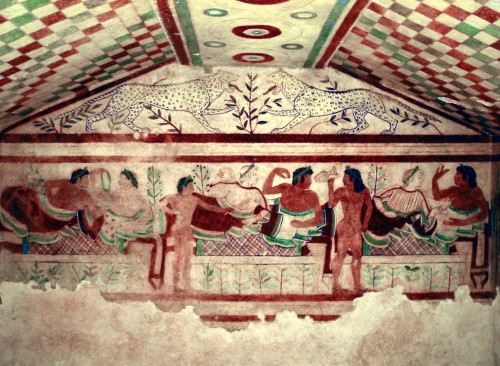
Tomb of The Lionesses, Tarquinia
SEATING ARRANGMENTS
Paintings suggest two kinds of social activity: banquets where food was served and diners reclined on one-armed couches which were covered in colourful rugs and cushions, and drinking parties where participants sat on the floor on mats. There are a few examples in early Etruscan art of diners sat on upright chairs, but by the 6th century BCE, the habit has changed to low couches in the style of those used at a Greek drinking party or symposium. Seating was arranged around the walls of the room so that all the guests could see each other as they ate. Food and wine were served by slaves and set on low, three-legged tables positioned in front of each diner.
BANQUET TABLES WOULD HAVE BEEN PILED HIGH WITH ALL MANNER OF EXOTIC FOODSTUFFS ALONGSIDE HOME-GROWN STAPLES.
FOOD & DRINK
Not only were the Etruscans accomplished farmers but they were also great traders, exchanging goods with all the Mediterranean cultures of the time from Phoenicia to southern Spain and North Africa. Consequently, for those who could afford such things, the banquet tables would have been piled high with all manner of exotic foodstuffs alongside home-grown staples. Meat included beef, lamb, pork, deer, boar, hare, and game birds. There was fish (especially tuna) and seafood aplenty, enormous rounds of sheep's cheese, olives, porridge, bread pancakes, vegetables, fruit, eggs, raisins and nuts.Flavours were enhanced by the addition of herbs, mint, honey, vinegar, pepper, and other spices. The Etruscans were great exporters of wine, too, so there would have been no shortage in that department either.
Such was the magnificent spread at Etruscan banquets that Diodorus Siculus, the 1st-century BCE Greek historian wrote, with a hint of envy in his disapproval,
As they inhabit a land fertile in fruits of all kinds and cultivate it assiduously, they enjoy an abundance of agricultural produce which not only is sufficient for themselves but by its excess leads them to unbridled luxury and indolence. For twice a day they have tables sumptuously dressed and laid with everything that can contribute towards delicate living; they have coverings embroidered with flowers and are served wine in quantities of silver bowls, and they have at their call a considerable number of slaves. (Heurgon, 36)
This view is confirmed by his contemporary, the Roman historian Livy, who describes the Etruscan elite as spending "most of their leisure enjoying themselves in entertainments on the most lavish scale" (Keller, 196).

Etruscan Banquet Scene
ENTERTAINMENT
Besides a good spread, musicians would have been present to liven up the atmosphere playing tortoiseshell lyres, castanets, and the double aulos flute. Diners seemed to have dressed for the occasion as they all wear extravagant, colourful, and expensive-looking clothes with wreaths of myrtle in their hair, and that is just the men; women have all that and fine jewellery too. For the drinking parties, an additional entertainment was the Greek game of kottabos where drinkers tried to throw their wine slops into a vase placed across the room or at an individual holding ceramic targets or even at a hapless passing slaveboy.
REPRESENTATIONS IN ART
Although only 2% of Etruscan tombs had their interior walls painted with scenes from daily life and mythology, of those the majority have at least one area devoted to a banqueting or drinking scene. The misleadingly named Tomb of the Lionesses at Tarquinia, built 530-520 BCE, actually has two painted panthers, a large drinking party scene, and is interesting for its unusual checkered pattern ceiling and six painted wooden columns. Does this recreate the older practice of covering the dead in tents or does it merely show an Etruscan love of eating outdoors?

Etruscan Diners, Tarquinia
The Tomb of the Monkey at Chiusi, constructed 480-470 BCE, has another drinking party scene which includes a female figure dancing while balancing an incense burner on her head in order to provide a target for drinkers to play kottabos. A rare glimpse behind the scenes is provided by the Golini Tomb at Orvieto (Volsini), where one wall shows the kitchens with eleven slaves, both male and female, busy preparing dinner with meat and birds hanging ready to be diced by one slave boy acting as butcher. Another figure is kneading or grinding something in a bowl and doing so to the music of a flute player nearby.
Banqueting scenes also frequently appear in Etruscan stone relief sculpture on the sides of funerary urns and sarcophagi. Two fine examples are from Chiusi. Dating to the 6th and 5th century BCE, respectively, they both have scenes where diners recline on one-armed couches while holding stemmed cups, with large wine-mixing kraters, musicians and even a dog in the background. Such scenes of festivity happily sit with more serious reliefs of mourning scenes on other sides of the same sarcophagus. Finally, sometimes terracotta moulded plaques used to decorate buildings depict banqueting scenes very similar to those already described. An example is a 6th-century BCE plaque from Acquarossa, which, again, has male and female diners, musicians, and dogs looking for scraps under the chairs.
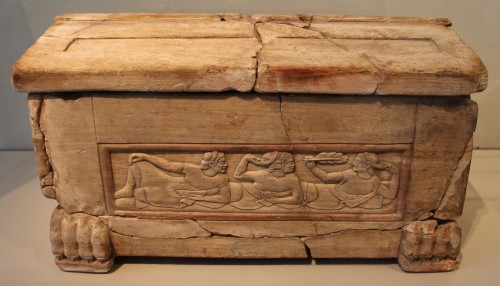
Etruscan Drinking Party
Taken together these social scenes give an important insight into the status of Etruscan women as they illustrate that they could attend when their counterparts in Greece could not. There only courtesans ( hetaerae ) could entertain the guests, but the inscriptions of some scenes indicate that respectable women participated on an equal footing with males in these Etruscan soirées. This was rather shocking to Greek writers, as seen in this extract from Athenaeus who quotes the 4th-century BCE writer Theopompus in his Learned Banquet,
They [Etruscan women] sit down to table not beside their own husbands but besides any of the guests, and they even drink to the health of anyone they please. Moreover they are great wine-bibblers and very beautiful to behold. (Heurgon, 34)
SOCIAL FUNCTION
We can only speculate as to the true significance of the painted banquets. Are they depictions of the deceased in a happy moment long since passed or mourners putting on a funeral feast for their lost loved one? Could they even be a view of the afterlife where food and drink and merriment never cease? The depositing of bucchero pottery dinner sets with cups, bowls, and utensils all neatly placed on a tray with the deceased suggests so. Perhaps, we shall never really know the link between Etruscan art and life.
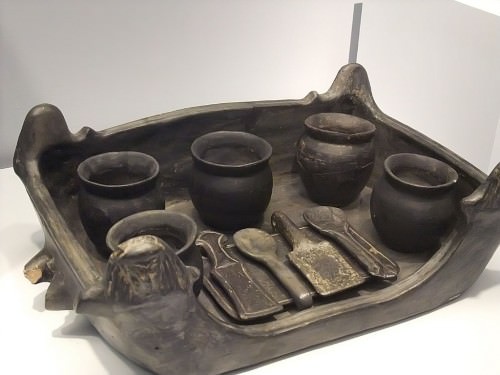
Bucchero Dinner Set
One thing which is clear, Etruscan art and clothing were influenced by Near Eastern cultures and Ionia, thanks to their trade connections, and so it would seem natural that habits of banqueting and drinking parties would also have been adopted. We should consider, too, that banquets might have been important opportunities for rulers to display their largesse with the common people and ensure their continued support of the status quo. This was a practice dating back to the Iron age Villanovan culture in Etruria.
Whatever the function of the banquets, whenever they were held, and whoever might have enjoyed them, it is clear from the paintings that enjoy them they did for rarely has the pure pleasure of eating and drinking been so vividly depicted in ancient art. The Etruscans knew how to let their hair down, of that there is no doubt.
See other Related Content for Ancient History ››
LICENSE
Article based on information obtained from these sources:with permission from the Website Ancient History Encyclopedia
Content is available under License Creative Commons: Attribution-NonCommercial-ShareAlike 3.0 Unported. CC-BY-NC-SA License